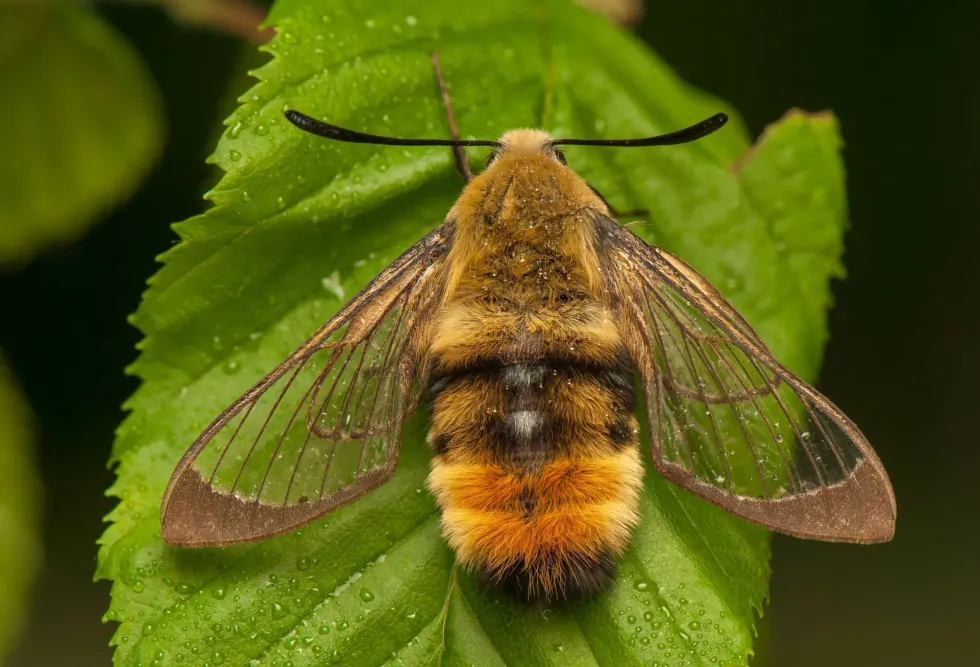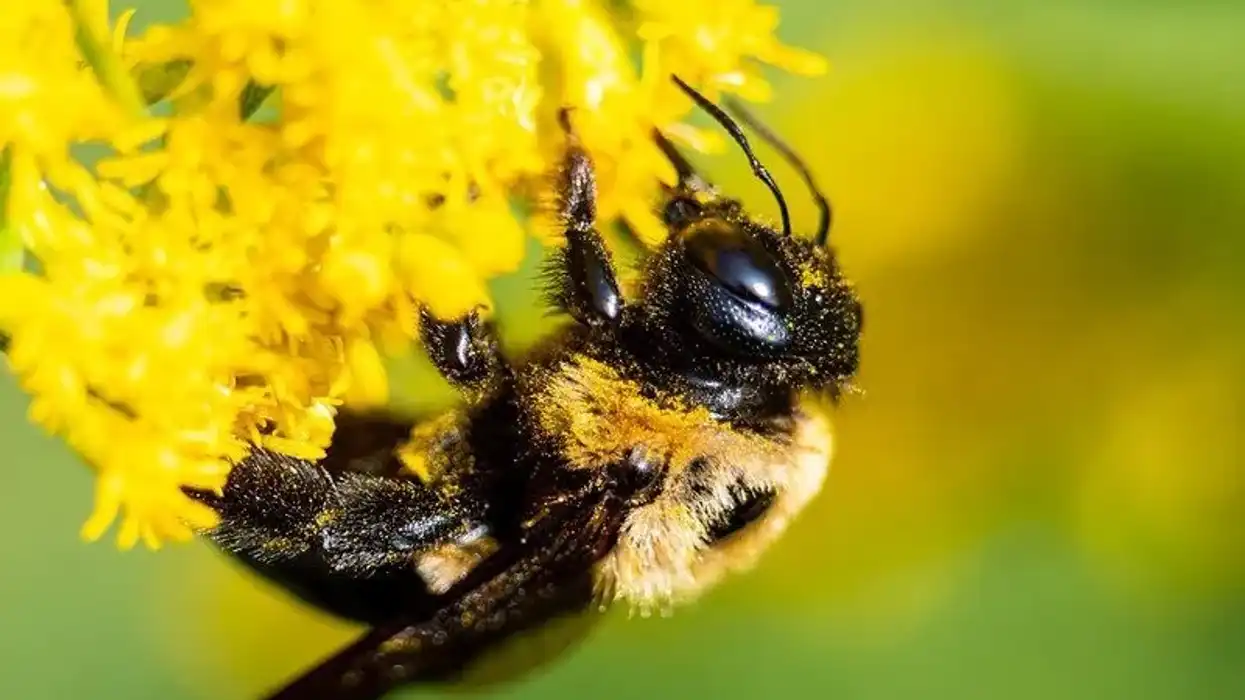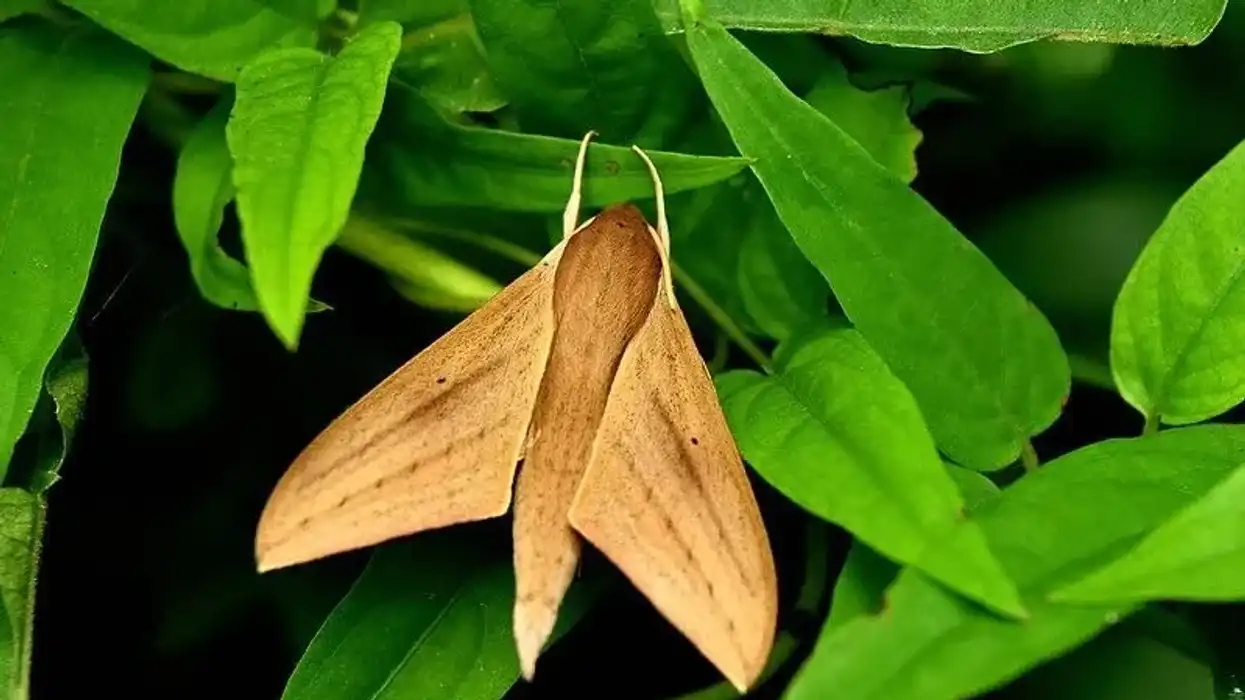Is it a moth or is it a bee? From the first glance at this insect, you'll be left scratching your head as it looks just like a bumblebee.
However, bee hawk moths are in fact two species of moths, the narrow-bordered bee hawk-moth and the broad-bordered bee hawk-moth. Similar to the usual bee, the body of these moths are covered in golden-yellow, brown, and white hair.
But, the broad-bordered bee hawk-moth does have a little more reddish tinge to it.
However, the beauty lies in the wing which will also help you understand that it's a moth. Their transparent wing has a narrow dark brown or maroon band along the outer edges.
The adults usually feed on the nectar found in flowers like snowberry and honeysuckle in their natural habitat while the larvae feed on green plant leaves. These are regarded as crepuscular or nocturnal species since they rarely come out in the daylight.
So, keep reading if you're interested in knowing more bee hawk-moth facts. Also, check out our articles on the genista broom moth and ailanthus webworm moth to learn about the world of insects.
Bee Hawk-Moth Interesting Facts
What type of animal is a bee hawk-moth?
The bee hawk-moth is a type of moth mainly belonging to the Sphingidae family.
What class of animal does a bee hawk-moth belong to?
The bee hawk-moth belongs to the class Insecta. Even the plume moths belong to the same class.
How many bee hawk-moths are there in the world?
As there are numerous bee hawk-moth species, it would be extremely difficult to put a concrete number on their population. Moreover, their distribution varies across continents and countries worldwide.
Where does a bee hawk-moth live?
The narrow-bordered bee hawk-moth, as well as the broad-bordered bee hawk-moth (Hemaris fuciformis), reside in similar locations around the world mainly in North Africa, Europe, and Asia. Additionally, the distribution range of the narrow-bordered bee hawk-moth is said to be from Ireland to the Ural mountains, going as far as the Altai.
They are also found in Mongolia and parts of northern China.
What is a bee hawk-moth's habitat?
The habitat of the bee hawk-moth also differs according to the species. The narrow-bordered bee hawk-moth prefers to inhabit untouched grasslands, damp pastures, and chalky downlands. While the broad-bordered bee hawk-moth prefers to live in areas with an abundance of food plants and also in heathlands and woodlands.
Who do bee hawk-moths live with?
Like other similar species, the bee hawk-moth only stays alive for a short time after turning into an adult moth. Hence, they are mostly found in solitary flights searching for food. However, as caterpillars, they can be seen in small clusters on common food plants like honeysuckle, devil's-bit scabious, and snowberry.
How long does a bee hawk-moth live?
The average lifespan of a bee hawk-moth after emerging from the pupal stage is around 10-30 days or even several weeks.
How do they reproduce?
Just like other moths, the narrow-bordered bee hawk-moth and the broad-bordered bee hawk moth (Hemaris fuciformis) reproduce by laying eggs. The eggs are usually green in color and it takes around 9-10 days for the eggs to fully mature and then hatches into larvae.
Female moths usually lay the eggs on the stalks and leaves of food plants, on which the larvae feed for sustenance.
The larvae of both bee hawk-moth species can be seen during the summer months. By August the feeding is done and it's ready to pupate and overwinter, till it can transform into an adult moth in the next summer.
What is their conservation status?
The bee hawk-moth (North America and other countries resident) is yet to be listed in any conservation lists.
Bee Hawk-Moth Fun Facts
What do bee hawk-moths look like?
Well, as you can guess, the bee hawk-moth looks quite similar to the usual bumblebee that has a plump abdomen. But, what makes these moths stand out have to be the beautiful wings that are fully displayed when it is flying.
The narrow-bordered bee hawk-moth has narrow or thin brown borders on its wings and a black ring around the abdomen. But, the broad-bordered bee hawk-moth (Hemaris fuciformis) has gorgeous has thick reddish-brown bands on the wings which can be seen while the moth is flying.
The rest of the body is covered in golden yellow and white hair.
Moreover, it also has two distinct reddish-brown bands around its abdomen. Both species are also known for their long antenna and forward-facing proboscis.
How cute are they?
Just like the giant leopard moth, the bumblebee hawk-moth is also quite cute as it looks fluffy and quite like a real bee.
How do they communicate?
The communication of moths is quite a mysterious thing. However, it has been noted that the female moth probably communicates with the male by spreading pheromones while flying. Some recent studies show that male moths may also communicate by producing low-intensity ultrasounds via their wings during the mating season.
How big is a bee hawk-moth?
Rather than measuring a moth by the length of its body, the wingspan is used to determine its size. The average size of the broad-bordered hawk-moth is around 1.5–1.9 in (38-48 mm).
While the wingspan of the narrow-bordered bee hawk-moth is around 1.6-2 in (40.6-50.8 mm). Compared to these bee hawk-moth species, the Promethea moth is a little bigger, measuring about 3-4 in (76.2-101.6 mm).
How fast can bee hawk-moths fly?
Even though we don't know the exact speed of this species, the average flight speed of hawk moths is 12 mph (19 kph).
How much does a bee hawk-moth weigh?
There's not much data on the weight of this moth species.
What are the male and female names of the species?
There are no separate names for the male and female of this species.
What would you call a baby bee hawk-moth?
A baby humming bee hawk-moth can be called larvae or a caterpillar.
What do they eat?
As caterpillars, they mainly feed on plant leaves. The caterpillars of the broad-bordered bee hawk moth can be found on food plants like wild honeysuckle and snowberry. While the narrow-bordered bee hawk moth caterpillars like feeding on devil's-bit scabious, small scabious, and field scabious. However, as adults, the moths feeding on nectar from flowers is common.
Are they dangerous?
No, the bee hawk-moths aren't dangerous or poisonous in nature and these surely don't bite.
Would they make a good pet?
No, this is a moth that is supposed to remain in its natural habitat. Also, having a relatively short lifespan, it wouldn't make a great pet.
Did you know...
Currently, 1,450 hawk-moth species have been identified.
As the bee hawk-moth looks similar to a bumblebee, it can often be called the bumble bee hawk-moth.
Different types of bee hawk-moth
As you already know about the broad-bordered bee hawk-moth and the narrow-bordered bee hawk-moth. One of the other similar species is the coffee bee hawk-moth (Cephonodes hylas) which belongs to the same family as the former two species, but to a different genus.
Are bee hawk-moths beneficial?
Yes, just like other moth species, the bee hawk-moth is also quite beneficial to its ecosystem. The bee hawk-moth help to pollinate flowers as its feet catch the pollens while it feeds on nectar from the flowers. Hence, without the contribution of these bee hawk-moth species, we wouldn't have beautiful flowers.
Here at Kidadl, we have carefully created lots of interesting family-friendly animal facts for everyone to discover! Learn more about some other insects from our puss moth facts and ivy bee fun facts pages.
You can even occupy yourself at home by coloring in one of our free printable bee hawk-moth coloring pages.
Second image by Ilia Ustyantsev from Russia.









